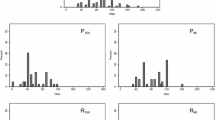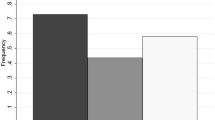Abstract
Ultimata bargaining experimentally investigates the responder behavior for multiple proposers, that is, the responder’s decision to accept or reject an offer conditional on another parallel offer. Responders’ strategies combine the two formally independent but parallel games as if inducing competition among proposers by more frequently rejecting an offer when it is the lower one of the two offers received simultaneously. Furthermore, proposers’ public offers strongly correlate, due to adapting over repetitions to the parallel offer or because of only slightly outbidding the other proposer’s offer if known before their own announcement. Social preferences of inequity aversion or of pure altruism for income distributions resulting from simultaneous ultimata cannot explain a positive dependency of own offers on other parallel offers, and joint responsibility is proposed as a reference-dependent social motive.





Similar content being viewed by others
Notes
In the standard ultimatum game two players divide an amount of money between them in the following sequence. The first player (the proposer) offers a part of the total amount and the second player (the responder) decides whether to accept or reject this offer. If the second player accepts, the amount is divided as suggested by the proposer. If the offer is rejected both players receive nothing. In the subgame perfect Nash equilibrium the responder accepts any positive amount and the proposer offers the smallest amount possible. Experimental or field investigations of the ultimatum game show that actual players of the game make non-negligible offers and responders reject low offers (i.e., Güth et al. 1982; Thaler 1988; Roth 1995; Camerer 2003). The various behavioral investigations of the ultimatum game also include high stakes or repeated interaction. High stakes slightly decrease rejection rates which in return leads to lower offers (Slonim and Roth 1998; Cameron 1999). Repeated interaction with fixed matching partners fosters higher rejection rates, presumably for building up the reputation of a tough player and thus increase future offers (Slembeck 1999). Furthermore, subjects prefer to reject only part of the offer when this is possible, instead of choosing zero payoffs for both players (Andreoni et al. 2003).
Through backward induction, rational responders should accept all positive offers, and proposers should offer the smallest amount possible (one eurocent here). Usually, in ultimatum experiments, responders reject small positive offers, and proposers offer between 30 and 50% of the pie.
Giving by the other proposer would reduce my givings to the responder due to diminishing utility. Warm glow would remain constant and, thus, independent of the other proposer’s givings. For rivalry to hold, the unreasonable responder behavior of consistently rejecting the lower offer must be fully anticipated.
The ranges are formed around the provided options under the one-shot strategy method. The appearance of the offer on the left side versus the right side of the screen did not affect general rejection rates. Only for the same amount for both proposers the rejection rates for the right side offer increases by 3.6%. Order effects of the offers as in Galinsky and Mussweiler (2001) are not further considered, and in the analysis rejection rates were averaged for all the same offers.
Significance levels are confirmed in a Wilcoxon signed rank test, with the only difference for comparing the standard ultimatum game with the simultaneous ultimata game for offers \(<20\)% being significant with \(p<0.01\).
References
Andreoni J (1990) Impure altruism and donations to public goods: a theory of warm-glow giving. Econ J 100:464–477
Andreoni J, Castillo M, Petrie R (2003) What do bargainers’ preferences look like? Experiments with a convex ultimatum game. Am Econ Rev 93:672–685
Batson C D, Lishner D A, Carpenter A, Dulin L, Harjusola-Webb S, Stocks E, Gale S, Hassan O, Sampat B (2003) “... As you would have them do unto you”: does imagining yourself in the other’s place stimulate moral action? Pers Soc Psychol Bull 29:1190–1201
Bohnet I, Zeckhauser R (2004) Social comparisons in ultimatum bargaining. Scand J Econ 106:495–510
Bolle F, Breitmoser Y, Heimel J, Vogel C (2012) Multiple motives of pro-social behavior: evidence from the solidarity game. Theory Decis 72:303–321
Bolton GE, Ockenfels A (1998) Strategy and equity: an ERC-analysis of the Güth-van Damme game. J Math Psychol 42:215–226
Bolton GE, Ockenfels A (2000) ERC: a theory of equity, reciprocity, and competition. Am Econ Rev 90:166–193
Bosch-Rosa C (2015) Tale of two tails: preferences of neutral third-parties in three-player ultimatum games. https://papers.ssrn.com/sol3/papers.cfm?abstract_id=2261081. Accessed 29 Oct 2018
Brandts J, Charness G (2011) The strategy versus the direct-response method: a first survey of experimental comparisons. Exp Econ 14:375–398
Camerer C (2003) Behavioral game theory: experiments in strategic interaction. The Roundtable series in behavioral economics. Russell Sage Foundation, New York
Cameron LA (1999) Raising the stakes in the ultimatum game: experimental evidence from Indonesia. Econ Inq 37:47–59
Cason TN, Mui V-L (1998) Social influence in the sequential dictator game. J Math Psychol 42:248–265
Coats JC, Hannan RL, Rankin FW, Towry KL (2013) Does reciprocity have a dark side: behavior in ultimatum games with multiple proposers. https://pdfs.semanticscholar.org/e0f1/e1556294367f3203ab004a502469b705bbce.pdf. Accessed 29 Oct 2018
Cooper DJ, Dutcher EG (2011) The dynamics of responder behavior in ultimatum games: a meta-study. Exp Econ 14:519–546
Croson R, Fatas E, Neugebauer T (2005) Reciprocity, matching and conditional cooperation in two public goods games. Econ Lett 87:95–101
Duffy J, Feltovich N (1999) Does observation of others affect learning in strategic environments? An experimental study. Int J Game Theory 28:131–152
Dufwenberg M, Kirchsteiger G (2004) A theory of sequential reciprocity. Games Econ Behav 47:268–298
Engelmann D, Strobel M (2004) Inequality aversion, efficiency, and maximin preferences in simple distribution experiments. Am Econ Rev 94:857–869
Engelmann D, Strobel M (2012) Deconstruction and reconstruction of an anomaly. Games Econ Behav 76:678–689
Falk A, Fehr E, Fischbacher U (2003) On the nature of fair behavior. Econ Inq 41:20–26
Falk A, Fischbacher U (2006) A theory of reciprocity. Games Econ Behav 54:293–315
Fehr E, Schmidt KM (1999) A theory of fairness, competition, and cooperation. Q J Econ 114:817–868
Fischbacher U (2007) z-Tree: Zurich toolbox for ready-made economic experiments. Exp Econ 10:171–178
Fischbacher U, Gächter S, Fehr E (2001) Are people conditionally cooperative? Evidence from a public goods experiment. Econ Lett 71:397–404
Galinsky AD, Maddux WW, Gilin D, White JB (2008) Why it pays to get inside the head of your opponent: the differential effects of perspective taking and empathy in negotiations. Psychol Sci 19:378–384
Galinsky A D, Mussweiler T (2001) First offers as anchors: the role of perspective-taking and negotiator focus. J Pers Soc Psychol 81:657
Grosskopf B (2003) Reinforcement and directional learning in the ultimatum game with responder competition. Exp Econ 6:141–158
Güth W, Huck S, Müller W (2001) The relevance of equal splits in ultimatum games. Games Econ Behav 37:161–169
Güth W, Huck S, Ockenfels P (1996) Two-level ultimatum bargaining with incomplete information: an experimental study. Econ J 106:593–604
Güth W, Marchand N, Rulliere J-L (1997) On the reliability of reciprocal fairness: an experimental study. Wirtschaftswissenschaftliche Fakultät, Berlin
Güth W, Schmittberger R, Schwarze B (1982) An experimental analysis of ultimatum bargaining. J Econ Behav Organ 3:367–388
Güth W, van Damme E (1998) Information, strategic behavior, and fairness in ultimatum bargaining: an experimental study. J Math Psychol 42:227–247
Halko M-L, Seppälä T (2006) Ultimatum game experiments. Unpublished. Helda-Helsingin yliopiston digitaalinen arkisto. https://helda.helsinki.fi/bitstream/handle/10138/16631/ultimatu.pdf?sequence=1. Accessed 29 Oct 2018 (Finland)
Harrison G, McCabe K (1996) Expectations and fairness in a simple bargaining experiment. Int J Game Theory 25:303–327. https://doi.org/10.1007/BF02425260
Hennig-Schmidt H, Irlenbusch B, Rilke RM, Walkowitz G (2017) Asymmetric outside options in ultimatum bargaining: a systematic analysis. Int J Game Theory 47(1):301–329
Heyes C (2011) Automatic imitation. Psychol Bull 137:463–483
Hopkins E (2008) Inequality, happiness and relative concerns: what actually is their relationship? J Econ Inequal 6:351–372
Kagel J, Wolfe K (2001) Tests of fairness models based on equity considerations in a three-person ultimatum game. Exp Econ 4:203–219
Keser C, Van Winden F (2000) Conditional cooperation and voluntary contributions to public goods. Scand J Econ 102:23–39
Knez MJ, Camerer CF (1995) Outside options and social comparison in three-player ultimatum game experiments. Games Econ Behav 10:65–94
Oxoby RJ, McLeish KN (2004) Sequential decision and strategy vector methods in ultimatum bargaining: evidence on the strength of other-regarding behavior. Econ Lett 84:399–405
Rabin M (1993) Incorporating fairness into game theory and economics. Am Econ Rev 83:1281–1302
Roth A (1995) Bargaining experiments. Handb Exp Econ 195:243–348
Roth AE, Prasnikar V, Okuno-Fujiwara M, Zamir S (1991) Bargaining and market behavior in Jerusalem, Ljubljana, Pittsburgh, and Tokyo: an experimental study. Am Econ Rev 81:1068–95
Selten R (1967) Die Strategiemethode zur Erforschung des engeschränkt rationalen Verhaltens im Rahmen eines Oligopolexperiments. In: Sauermann H (ed) Beiträge zur Experimentellen Wirtschaftsforschung. J. C. B. Mohr, Tübingen, pp 136–168
Selten R, Ockenfels A (1998) An experimental solidarity game. J Econ Behav Organ 34:517–539
Simonson I (1989) Choice based on reasons: the case of attraction and compromise effects. J Consum Res 16:158–174
Slembeck T (1999) Reputations and fairness in bargaining—experimental evidence from a repeated ultimatum game with fixed opponents. Experimental 9905002, EconWPA, May 1999
Slonim R, Roth AE (1998) Learning in high stakes ultimatum games: an experiment in the Slovak Republic. Econometrica 66:569–596
Stewart N, Chater N, Brown G (2006) Decision by sampling. Cogn Psychol 53:1–26
Thaler RH (1988) The ultimatum game. J Econ Perspect 2:195–206
Tversky A, Kahneman D (1974) Judgment under uncertainty: heuristics and biases. Science 185:1124–1131
Tversky A, Kahneman D (1991) Loss aversion in riskless choice: a reference-dependent model. Q J Econ 106:1039–61
Van Baaren RB, Holland RW, Kawakami K, Van Knippenberg A (2004) Mimicry and prosocial behavior. Psychol Sci 15:71–74
Author information
Authors and Affiliations
Corresponding author
Electronic supplementary material
Below is the link to the electronic supplementary material.
Appendices
Appendix
Regression Analysis
The rejection rates are influenced not only by the current offer, but also by the parallel offer received simultaneously. The restricted maximum likelihood regression analysis for the repeated (1120 observations for 28 responders) and the one-shot (4200 observations of 84 responders) ultimata games clearly illustrates this dependency. Note that the relative comparison, as being the lower offer of the two, has a stronger influence on the rejection rate than the absolute amount of the parallel offer. The absolute amount is important as of the previous offer in the repeated ultimata game. Here also the period (with 20 repetitions) remains influential, while the information treatment does not have any significant effect. In both the repeated and the one-shot ultimata game the best model, according to the Akaike information criterion (AIC), results when the amount of the parallel offer is replaced by its relative differences (i.e., the current offer being the lower offer) capturing a kind of “comparative dependency”.
Rights and permissions
About this article
Cite this article
Otto, P.E., Dittmer, D. Simultaneous but independent ultimatum game: strategic elasticity or social motive dependency?. Int J Game Theory 48, 61–80 (2019). https://doi.org/10.1007/s00182-018-0646-6
Accepted:
Published:
Issue Date:
DOI: https://doi.org/10.1007/s00182-018-0646-6
Keywords
- Multiple ultimatum game
- Context dependency
- Responder rejection rate
- Joint responsibility
- Comparative dependency




